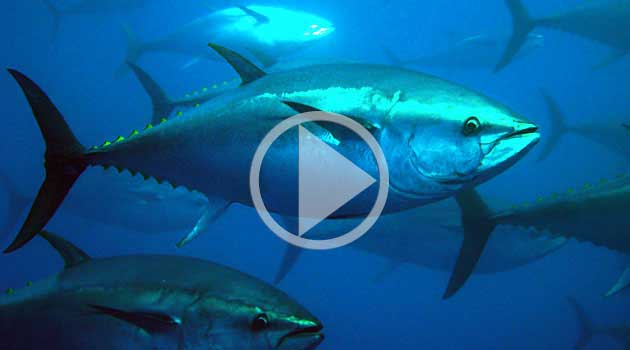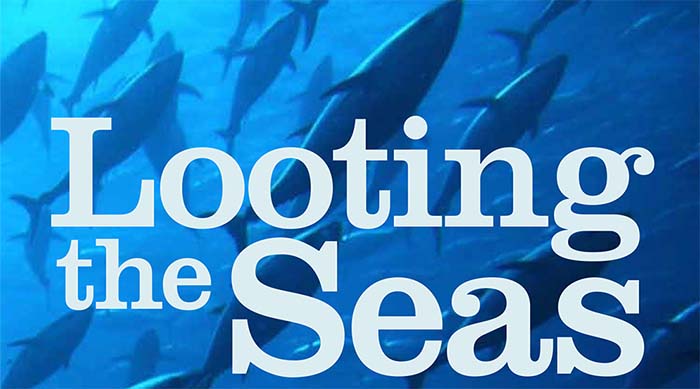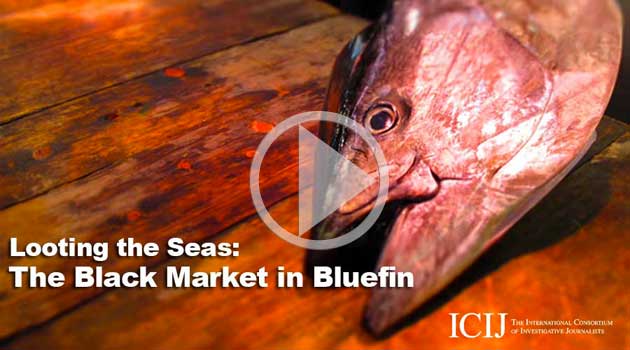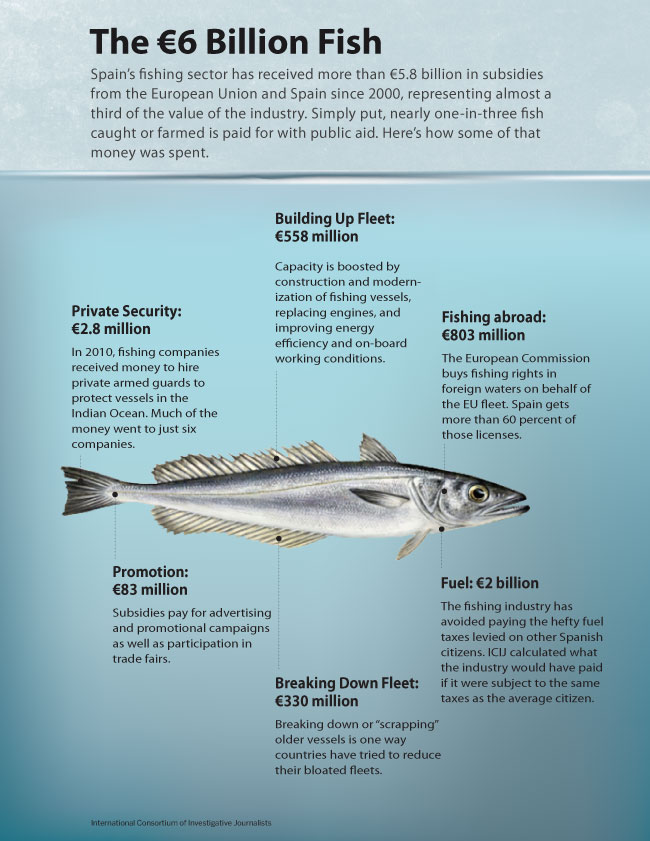In the final days of 1996, the air was cold and seas rough around the southern Spanish port of Cartagena. A boat belonging to the Tuna Graso sea “ranch” — a joint venture between Japan’s Mitsui & Co. and Spain’s Ricardo Fuentes & Sons — had just pulled aboard a huge 300-kilo bluefin tuna from one of its underwater pens. That single fish was worth $17,000 to the company, and would fetch far more at auction in Tokyo.
The days of supplying fresh bluefin tuna just a few months a year were over. The introduction of fattening ranches, or farms, meant the Japanese could have high-quality bluefin for their sashimi year-round. Tuna captured at sea could now be transferred into cages and fattened for months in underwater coastal cages until Japanese buyers were ready to deal.
That blustery day, the boat’s captain gave the order to return to dock. But in the choppy water, the big fish began to slide around the deck, thrashing violently. It injured crew members and endangered Japanese quality-control officers and Tuna Graso executives before falling overboard into the sea.
According to Pepe Amat, a former manager at Fuentes & Sons who witnessed the episode, these were the experimental years, when the goal was to perfect the methods for fishing, caging, harvesting, and trading bluefin tuna. No one had ever before attempted to commercialize giant bluefin fattened on farms, and accidents were bound to happen.
In the end, it was a minor setback to a method that would transform the industry over the next 15 years. Ranching the Eastern Atlantic bluefin tuna quickly became a multi-million dollar enterprise, with some 67 ranches spread across the Mediterranean. At the same time, the ranches would become the epicenter of an off-the-books trade that would decimate the region’s bluefin, until nearly 75 percent of the stock had disappeared.
In the closed culture of bluefin fishing, authorities, fishermen and ranchers can be as opaque as the waters on which they rely. They are part of a flawed system in which, for more than a decade, fishermen, ranchers, and traders engaged in widespread fraud and negligence, according to a seven-month inquiry by the International Consortium of Investigative Journalists (ICIJ). The rampant rule-breaking gave rise to a black market in the prized tuna. At its peak, from 1998 to 2007, the illegal trade comprised more than one out of every three bluefin caught, at a market value of about $400 million annually, ICIJ found.
Cheating is particularly rife in the ranches’ murky waters, according to dozens of interviews with ranchers, fishermen, divers, traders, politicians, inspectors, and scientists. Among the illegal practices: underreporting numbers of bluefin caught, towed, caged, and sold; ranching of undersized fish; fake releases when forced by authorities to free already-illegally penned fish; under-declaring harvests and trading figures to comply on paper with legal quotas; and installing cages without permission. “Before the existence of the farms, the tuna market in the Mediterranean lasted only three months,” recounted a Spanish official who for years oversaw the industry. “The possibility of caging live bluefin gave rise to increased fishing capacity and over-catching.”

Intent on marketing the best quality bluefin back home, Japanese companies were the architects and financiers of the ranching industry. They partnered with Spanish and Croatian fishmongers to launch the innovative facilities. As the industry grew, and Mediterranean fishermen and ranchers engaged in a profitable gold rush, regulators turned a blind eye.
The fate of Mediterranean bluefin rests with the International Commission for the Conservation of Atlantic Tunas, an intergovernmental organization of 47 countries and the EU. ICCAT set the total allowable catch of bluefin at 13,500 metric tons this year, down from 22,000 in 2009. Yet the recorded capacity of the regions ranches is nearly five times the current quota, according to ICCAT, with many ranches located in loosely regulated countries such as Turkey and Tunisia.
So controversial are these ranches that the Japanese, who buy 80 percent of the world’s supply, are starting to balk at excesses in the industry. Last year, officials in Japan took the unprecedented step of blocking the entrance of more than frozen 3,500 tons of Atlantic bluefin — about one-sixth of the country’s annual imports. All of it came from Mediterranean ranches. Inspectors found some ranches were claiming to fatten tuna at levels that were biologically impossible, while others were exporting more fish to Japan than they had taken in. The Japanese eventually released all but 800 tons, but their point was clear. “If no set-up is in place for legally carrying out ranching, then it should be stopped for a while, and it should be cleaned up,” warned Masanori Miyahara, Japan’s senior delegate to ICCAT.
Mediterranean Ranchers, Japanese Traders
Spurred by Japanese demand, the industry began to evolve rapidly in the 1990s. Big purse seining vessels — named for nets that close from below like a draw-string purse — could catch 3,000 tuna at a time. Selling them to ranches instead of directly to Japanese buyers increased their bottom line. “We were fishing a huge amount of bluefin, killing them at catch time, and selling it very cheap to the Japanese,” recounted Francisco Martínez, who pioneered ranching in the Mediterranean by opening a ranch in Spain in 1994. “Then, I went to Japan to study the market and realized that it was the moment to stop doing stupid things. It was the time to develop ranching in order to add value to that fishery.”
Ranching had proved successful in Australia, and the model was adapted to the Mediterranean. At sea, purse seiners transfer their catches to cages. A tugboat then tows them to ranches in coastal waters, at speeds of just two kilometers per hour, on journeys across the Mediterranean that can take a month. Once in these circular pens, the fish are fattened for months on sardine, mackerel, and herring until they obtain the fattiness, flavor and color that Japanese consumers demand. At “harvest,” the tuna are shot in the head and hauled aboard a vessel, to be gutted and their heads chain-sawed off. They are immediately dipped into a -2ºC seawater slush. Within hours most of the fish are deep-frozen onboard refrigerated vessels to be shipped to Japan. Others are packed, air freighted, and auctioned fresh in Japanese markets.
Most of the bluefin at the ranches are adult fish. Scientists have been trying to raise Atlantic bluefin from larvae, but the migratory fish generally don’t survive more than a few weeks.
“No Effective Controls”
For years the ranching business boomed. Spanish ranchers dominated the business, first from Spain, and then through joint ventures with both local and Japanese partners in Croatia, Malta, Turkey, Italy, Tunisia, Cyprus, and Libya. Most of the fish were bought from Italian, French, and Spanish purse seine fleets.
The industry — and the EU — poured cash into modernizing the fleets, mainly the purse seiners and tugboats that supplied the ranches with live fish. But the investment created a vicious cycle, ranchers and officials say. Once the ship owners had purchased multimillion dollar vessels, they were forced to overfish to re-pay bank loans.
As fishing grounds grew depleted, the fleets and ranches moved on from southern Europe to Tunisia and Libya in search of new sources of bluefin, industry veterans say. Starting in 2002, the once rich Balearic fishing ground off Spain “was about to collapse due to over-catching,” recalls Manel Balfegó, a fifth-generation Spanish tuna fisherman and co-owner of a ranching company. “It was necessary to open ranches near the Libyan waters.”
Overfishing and the spread of ranches forced the bluefin population into a nose-dive, cutting it by nearly 75 percent over 40 years —more than half of that between 1997 and 2007, according to ICCAT figures. Some of the loss was due to liberal quotas, which ICCAT’s own scientists warned were too high. But much of it came from unreported and illegal catches, which accounted for up to half of all fish caught some years.
The structure of the ranches has made it easy to cover up the overcatch, ranching veterans say. Catches and transfers are carried out on open seas and with vessels and operators of multiple nationalities, each subject to different legislation. The ranches operate largely underwater and typically rely on divers’ estimates to document the numbers of fish brought in and sold. “I was a witness to the overfishing and overfarming,” said Emmanuel Delia, a professional diver for years with ranching companies in his native Malta. “There were no effective controls enforced on the bluefin industry before 2008.”
A former manager for a prominent Mediterranean rancher blamed the off-the-books sales on underestimates of fish at the ranches. “Divers count the transfers of the bluefin tuna from the purse seiners to the towing cages, and from these to the fattening cages, with a guess,” he explained. At slaughter, the rancher may realize that he owns more tuna than previously reported. “For the fish that are over quota, you have to find a solution” at the end of the season, said the former manager. Releasing the fish — and losing one’s investment — is simply not an option, he explained. A rancher has two choices: “You either trade it illegally or keep it until the next season… We took the over-quota fish to Tunisia.”
To combat the fraud and misreporting, ICCAT in 2008 implemented a reporting system called the Bluefin Tuna Catch Document Scheme (BCD), a program that the European Commission lauded as bringing “complete and reliable traceability” to the trade. Under the system, vessels are given a unique number for each catch. That number follows the catch to ranch, through harvest and finally to market. All along the supply chain, players are required to provide detailed information about the number, size, and location of the fish. The hand-written documents are validated by national fisheries authorities and submitted to ICCAT, where the data are manually entered into a database.
ICIJ gained access to the BCD database through an ICCAT member country, and its analysis found the system riddled with incomplete and contradictory information. Of the 4,102 entries for 2008 and 2009, 44 percent lack either a BCD number or other critical information related to vessel, catch, or destination. At least 96 records of shipments to Japan — equivalent to 5,000 tons — could not be traced back to a ranch or vessel in the database. Perhaps that explains why Jean-Marc Fromentin, a member of ICCAT’s Scientific Committee, called the BCD database “a bloody mess.”
BCD data related to ranches appear particularly problematic. At least 20 percent of the bluefin reported killed in ranches during those years — some 118,000 fish — lack trade information, effectively turning those fish into ghost tuna that regulators can’t track to their final destination. Perhaps most striking, the ranches appear to magically manufacture additional bluefin. More than a dozen Mediterranean ranches slaughtered more fish than they bought, according to the database. “This is incomprehensible, no matter which way you look at it,” commented ICCAT Japanese head Miyahara. “It is not as if the fish lay eggs and propagate while in the pen. We said this is nonsense.”
The Fuentes Group
Among the ranches that have attracted the attention of authorities is Drvenik Tuna, co-owned by Ricardo Fuentes e Hijos (Ricardo Fuentes & Sons), the Mediterranean’s leading ranch company. Paco Fuentes, the company’s general manager for the last two decades, turned a humble family business into a powerful company through savvy deal-making. In the 1960s, his father sold salted fish door to door from a bicycle; now Fuentes flies across the Mediterranean in a private chartered jet.
In the early 1990s, the Japanese took notice of Paco while competing against him at bluefin auctions, and soon he was making deals with some of Japan’s top trading companies: Mitsui & Co. and, later, Mitsubishi Corporation and Maruha. In 1996, Fuentes & Sons opened a ranch in Spain, and since then the company has expanded its ranching activities to Croatia, Italy, Turkey, Malta, Cyprus, Libya, and Tunisia. In 2003, Fuentes, dubbed Paco-san by his Japanese partners, “boasted of having caught 16,000 tons of fish — 50 percent of all bluefin tuna fished in the Mediterranean,” according to a former manager at Fuentes & Sons. Today the company owns eight ranching subsidiaries in six countries. Paco-san shows little sympathy for those who warn the bluefin is in trouble. “There are a lot of small bluefin tunas in the Gulf of Lion waters” near France, he asserts. “It’s not true that the bluefin tuna stock is an endangered species.”
Fuentes jointly owns Drvenik Tuna, a Croatian ranch, with Japanese corporate giant Mitsubishi and local partner Conex Trade. Drvenik has drawn criticism from officials, NGOs and citizens since its founding in 1998. Among the complaints: building a ranch without appropriate authorization; and operating a vessel without valid documents, according to enforcement records and interviews. Environmentalists have also complained that the company polluted nearby waters by dumping fish remains.
In December 2008, Drvenik Tuna was forced to release 712 bluefins caught by French vessels after officials ruled the catch had been taken illegally, according to an ICCAT compliance report. A year later, Japanese officials refused entry of 560 tons of bluefin fattened at a Fuentes ranch in Tunisia because the Algerian-caught fish had no accompanying BCD, according to Tunisian government records. Again, Fuentes was ordered to release the fish.
Drvenik is also the subject of a complaint filed by the city of Milna in southern Croatia, alleging that in 2006 a Drvenik subsidiary built a tuna ranch without proper authorization in Stipanska Bay, a pristine coastal area. A local NGO threatened to hire divers to cut open the cages, so no fish were ever brought to the ranch. A police investigation followed the complaint, and prosecutors told ICIJ they are now deciding whether to follow with a formal indictment regarding the allegedly improper construction.
Fuentes managers at its Cartagena, Spain, headquarters responded that there were some issues with Drvenik in the past, but referred ICIJ to Mladen Milakovic, their Croatian partner and manager. Milakovic declined to comment. Mitsubishi said Drvenik has not received “any official letter or document” from Croatian officials regarding the complaint and is “in full compliance with local and ICCAT regulations.”
The company’s troubles are not limited to Tunisia and Croatia. In late 2008 a government inspection of Caladeros del Mediterraneo, a Fuentes & Sons company in Spain, found that the ranch had fattened more tuna than it declared, and was told to release the fish. David Martínez, Fuentes assistant manager, said the problem was not that they didn’t declare fish, but that their legal fish had gained too much weight.
The Maltese Bluefin
Fuentes & Sons is not the only rancher to attract controversy.
The tiny island of Malta, 90 kilometers from Sicily, has built up the Mediterranean’s largest bluefin ranching capacity in the last five years, and in 2007 alone processed 11,360 tons of the fish — nearly 40 percent of ICCAT’s entire quota for that year.
In 2007, journalist Raphael Vassallo with Malta Today began writing about the local ranchers, pointing out alleged shortcomings in import-export data, fattening rates that appeared biologically impossible, and an illegal case of re-flagging vessels. Vassallo and his newspaper were later hit with what he calls “a mass libel legal action by all five companies” on the island — Ta'Mattew Fish Farms, Fish & Fish Tuna Ranch, Malta Fish Farms, AJD Tuna, and Mare Blu Tuna Ranch. The companies blamed Vassallo for financial losses stemming from his “libelous” and “defamatory” allegations, the reporter says. “The situation as it stands today is that all charges against me personally have been dropped,” Vassallo told ICIJ, “but the cases against the newspaper have been retained… presumably, for as long as it takes to stop us from reporting the issue.”
Others are raising questions about bluefin from Malta’s ranches. When Japanese inspectors last year blocked the import of more than 3,500 tons of bluefin, much of the supply came from Maltese ranches. The amount constituted “most of the tuna farmed in Malta, the equivalent to €40 million,” according to Malta Director of Fisheries Control Andreina Fenech. The Japanese are still blocking €8 million worth of Maltese bluefin. “The last months have been very tough for the Maltese ranchers,” Fenech added.
ICIJ’s analysis of BCD data suggests why Japanese inspectors may have raised questions about bluefin from Mediterranean ranches. More than a dozen ranches appear to have harvested more fish than they reported transferring into their cages. For example, in May 2008, a Turkish vessel reported catching 580 tuna, and transferring those fish into cages belonging to Sagun, a leading ranch in Turkey. But when Sagun reported the harvest of those fish five months later, the BCD data show that it pulled out 2,866 fish —nearly five times the number that went in.
“Our company has been acting in accordance with international and national regulations,” Sagun wrote in response to ICIJ’s request for comment. “The allegations of wrongdoing have nothing to do with our firm.”
The EU, Japan, and Bluefin
Mediterranean ranchers have seen better days. Although criticized as too high by some scientists, an ICCAT quota of 13,500 tons for 2010 has forced the ranchers to cut back on production, they say. Industry sources estimate this year will bring in revenues of some $310 million, down from $490 million in 2008. Fuentes Group managers say that of the company’s eight ranching subsidiaries, only three are operating.
In Brussels, meanwhile, a new EU Commissioner for Maritime Affairs and Fisheries — Greece’s Maria Damanaki — is threatening “to close the fishery if there is no compliance.” The ranchers see Damanaki as an avid environmentalist — “green as a bottle of Heineken,” as one manager put it.
Even the Japanese, after helping finance and set up the ranching industry, are having second thoughts. By 2008, criticism from environmentalists and warnings from scientists about plummeting bluefin stocks were starting to have an impact, prompting a public pledge by top buyer Mitsubishi to support a sustainable fishery. To show they were serious, last year Japanese officials made their first big refusals of bluefin imports, citing dubious paperwork by suppliers. At the end of 2009, ICIJ has learned, Tokyo temporarily halted imports from Tunisia after, among other problems, ranches there reported harvesting more fish than they took in.
If Japanese officials needed further convincing of the need for a crackdown, it came last March, when their delegates had to marshal forces to block an international attempt — sponsored by Monaco and backed by the EU and US — to ban Atlantic bluefin trade by listing it under CITES, the Convention on International Trade in Endangered Species. Now Japan’s chief ICCAT delegate Miyahara, in a September interview with ICIJ, has warned that his country will consider supporting a temporary shut down of the ranches.
Not everyone is sympathetic to Japan’s new-found rigor. “The Japanese are the designers and financiers of the Mediterranean farming system,” said Sergi Tudela, head of Fisheries at WWF Mediterranean. “They wanted the fatty fish and they recruited the people who could carry out this work for them. Now that the system is out of control and markets are saturated, they are scrambling to distance themselves from it.”
How far Japanese officials will go remains to be seen. Demand for the prized bluefin will be hard to dampen in the markets and sushi bars of Tokyo and Osaka, and Japan remains by far the world’s biggest buyer. Despite concern by some ranchers, few believe the Japanese will support a moratorium on bluefin fishing when ICCAT holds its annual meeting this month. “Japan has the last word on the ICCAT decisions,” said a confident Negi Toumi, general manager of Tuna Farms of Tunisia. “The Japanese want to go ahead with their trading strategy — and that is a guarantee for us.”






